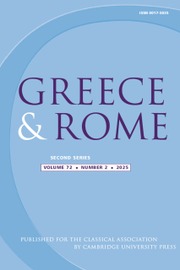Article contents
The Tragic Vision of Aeschylus
Published online by Cambridge University Press: 05 January 2009
Extract
On two sides productive work for the understanding of Aeschylean tragedy has lately been done. Cambridge scholars have made useful progress in the elucidation of Aeschylus, and recent new interpretations of the symbolic and prophetic meaning of later poetry, including the New Testament, have produced results which can be applied with caution to tragic poetry in general. A combination of the methods of these investigators, which yet does not abandon all the estimates of older criticism, may, by a slight change of perspective, enable further progress in the interpretation of Aeschylus to be made.
- Type
- Research Article
- Information
- Copyright
- Copyright © The Classical Association 1935
References
NOTES
The chief authorities in English relevant to these questions are the following: Cornford, F. M., Thucydides Mythistoricus (London, 1907), pp. 137–49Google Scholar (for the symbolic character of the art of Aeschylus); Thomson, George, Aeschylus, The Prometheus Bound, edited with Introduction, Commentary, and Translation (Cambridge, 1932), pp. 1–46Google Scholar, especially 3–4 (for the problem of justice in Aeschylus, the suffering of the Danaids in the Supplices, and the nature of Heracles in the Prometheia, 6–12 (for the character of Zeus in the Prometheia, and the concept of evolution), 16–17, 31 (for Heracles in the Prometheia), 38–46 (for the authenticity and date of the play); Knight, G. Wilson, The Christian Renaissance (Toronto, 1933)Google Scholar, passim (for the mythical humanism of the plays of Shakespeare, the Bible, and other poetic works; cf. other books by the same writer); Farnell, L. R., in Journal of Hellenic Studies, liii. (1933), pp. 40–50CrossRefGoogle Scholar (for the Satanic character of Zeus in the Prometheus vinctus); Adams, S. M., in Classical Philology, xxviii (1933), pp. 97–103CrossRefGoogle Scholar (for the magical contest in the Prometheus vinctus); Lawson, J. C., The Agamemnon of Aeschylus, a Revised Text with Introduction, Verse Translation, and Critical Notes (Cambridge, 1932), p. xxxiiiGoogle Scholar (for further remarks on the tragic question, ‘What is Justice?’); and now also Owen, E. T., in The University of Toronto Quarterly, 07, 1934, pp. 498–510CrossRefGoogle Scholar (for an unusually enlightening account of the nature of Aeschylean tragedy, in which I am happy to find some confirmation of the opinions, independently formed, which are offered here).
The end of the Septem contra Thebas is now rejected as spurious. This rejection I am not prepared to contest. But I have included the passage in my treatment, since its coherence with the main development of the thought of Aeschylus may be worth attention, if the question of authenticity is ever raised again; and since, even if it is not, this coherence, on modern critical principles, must still retain a certain relevance.
- 1
- Cited by


